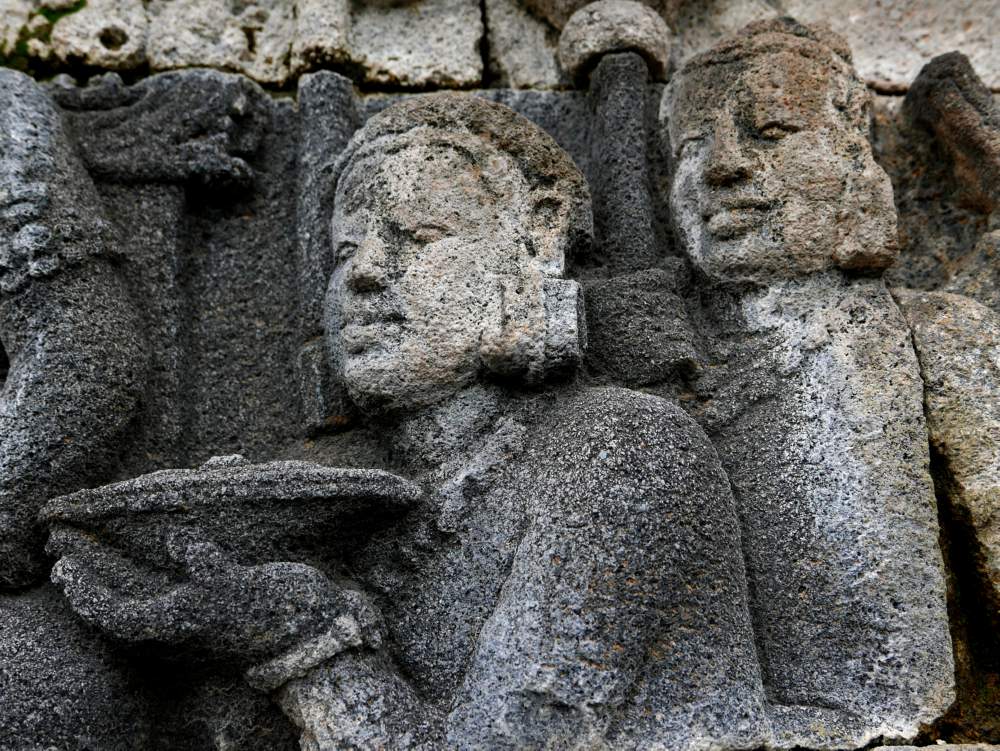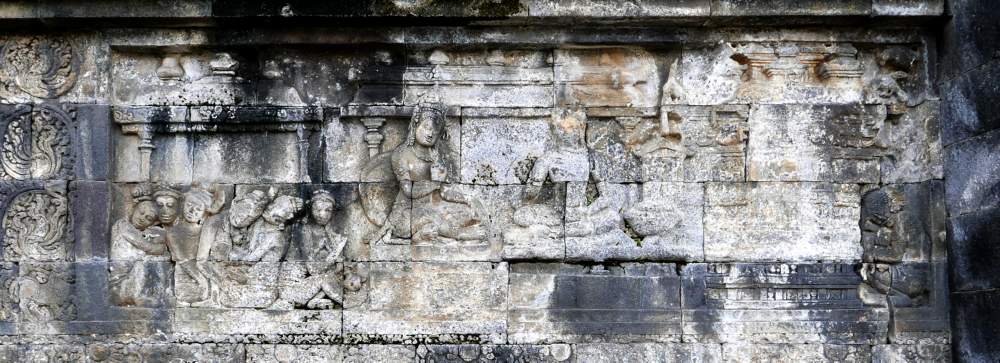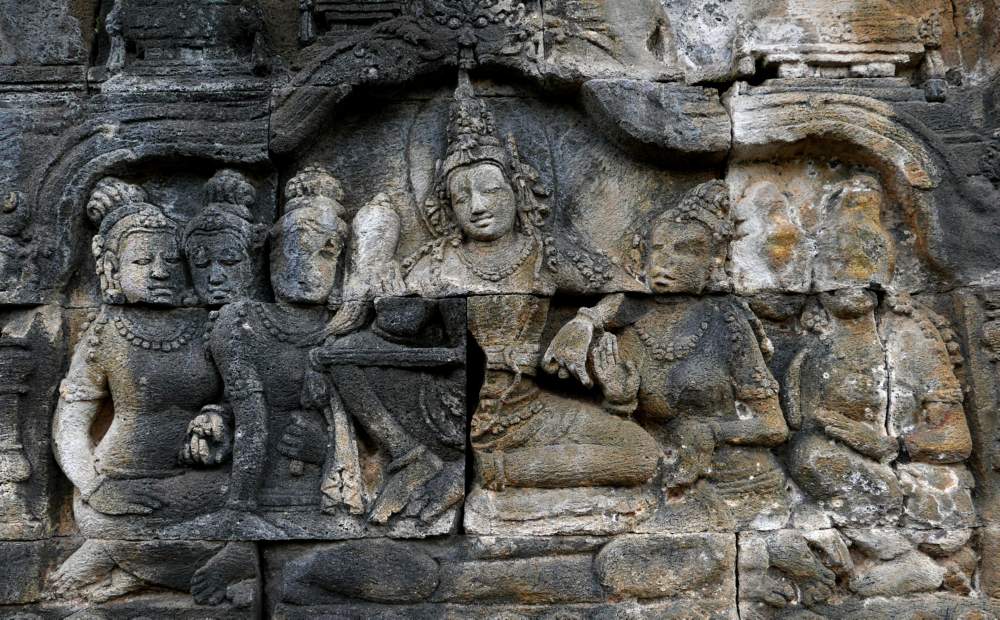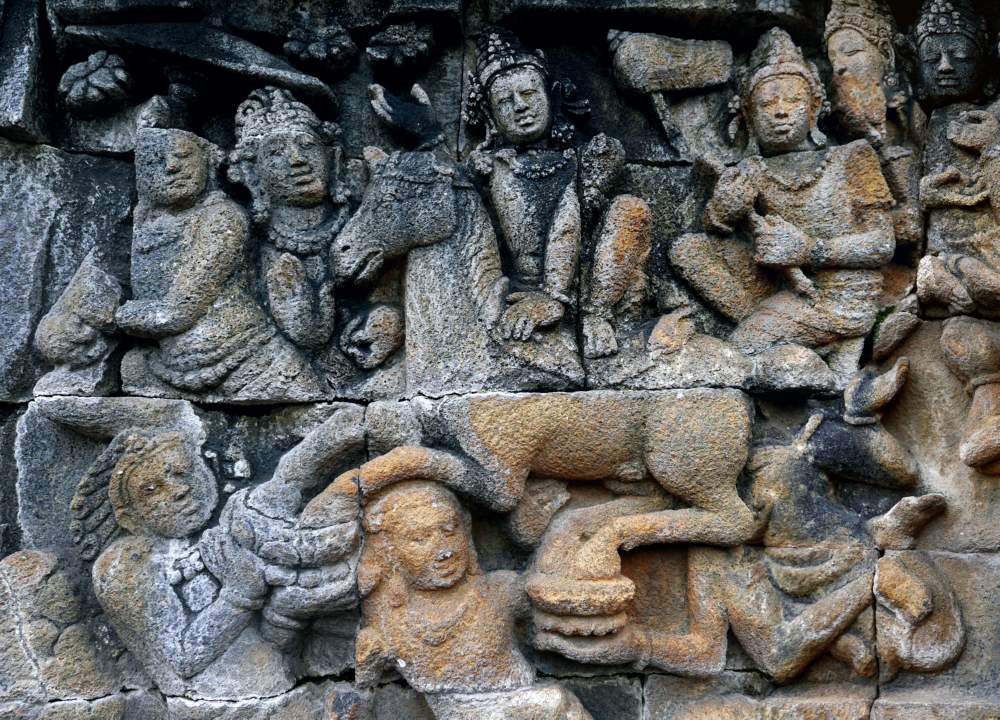a complete collection of high-definition creative commons photographs from Borobudur, Java, illustrating the Life of the Buddha as told in the Lalitavistara, together with further information.
(opens in a lytebox, without leaving the page)
use j/k or left/right arrow
to navigate through the photos below
3. Signs & Renunciation
53. The Gods remind Sarvārthasiddha of his Duties
While the Prince is in his quarters, surrounded by his court, many gods and other great beings come and remind him of his duty to go forth and strive for Buddhahood.
Lalitavistara explains that the Bodhisattva did not need to be exhorted, as he knew the right time for everything, but it is the tradition that the gods should make their request.
54. Sarvārthasiddha is presented with Three Palaces
Then King Śuddhodana, heeding the signs, thought to prevent the Prince from going forth by building him three Palaces for the three seasons and surrounding him with luxuries and distracting him with sense-pleasures.
In the relief we see the three Palaces, and the Prince sitting in two of them. It is not immediately clear why the third is empty.
55. The City is prepared for Sarvārthasiddha’s trip outside the Palace
Then the Prince, who was growing more and more melancholy in the Palace, told his charioteer that he wanted to visit the outside world. The King allowed it, thinking he would appreciate his Palace life all the more, and he had the city made ready with the four fold army, and the streets cleared of unpleasant sights and sounds.
On the right of the panel the Prince is seen sitting with Gopā, and surrounded by ladies in waiting. On the left the city is being prepared with elephants, soldiers and others holding what looks like a lotus flower.
56. Sarvārthasiddha sees an Old Man
As the Prince is being taken through the eastern gate of the city the gods create an image of an old man, and the Prince asks his charioteer: are all men subject to this, and he replies, they are, and the Prince, realising the truth of old age, asks to be returned back to the Palace.
The old man is on the far left of the panel, holding his staff, and being helped along by a child. A pair of horses pull the chariot the Prince sits on, and he appears to be turning away from the old man, perhaps with the idea of returning now to the Palace.
57. Sarvārthasiddha encounters a Sick Man
For a second time the Prince asks to go into the city and the chariot is prepared, and goes through the southern gate. This time he sees a sick man, and realises the universal truth of being subject to ill-health.
The sick man is again on the far left of the panel as we look, and here the Prince appears to be in conversation with his charioteer, who answers his questions about sickness.
58. Sarvārthasiddha sees someone who has Died
On his third trip outside the Palace the Prince goes through the western gate and sees someone lying dead on a bier, and has a similar conversation about death, and realises the truth of the mortality of all beings.
The dead man lies on a bier on the far left, with his family gathered round him, while the Prince contemplates these matters and converses with his charioteer.
59. Sarvārthasiddha meets an Ascetic
On his fourth trip the Prince goes through the northern gate of the city, and the gods create a vision of an ascetic standing serenely on the path, with his senses subdued.
The ascetic (śramaṇa) is figured on the far left, while in the middle the Bodhisattva converses with the charioteer, who this time explains to him the monastic life, which is one of restraint and truth-seeking.
60. Gopā tells her nightmare to Sarvārthasiddha
One night Gopā sees what she feels is a terrifying nightmare, but it is interpreted very differently by the Prince, who explains it is owing to her great virtue that she sees such a dream, and interprets the signs as auspicious.
In this rather worn panel the Prince sits in the middle, with Gopā at his feet on his right, around sit courtiers who listen to the interpretation proffered.
61. King Śuddhodana gives permission for Sarvārthasiddha to leave the Palace
The King wishes to prevent the Bodhisattva from leaving on his quest, and offers him whatever he desires. The Prince asks for four boons: that he may not grow old, sick or die, and that his wealth will never diminish. The King of course, cannot give these things, and therefore consents to his going-forth.
The King and the Prince are sitting in the centre discussing these issues, and courtiers sit behind the prince waiting to hear the result of the conversation.
062. Gautamī brings beautiful women for the Prince
The Prince’s stepmother Mahā Prajāpatī Gautamī now instructs the maidservants to keep good watch over the Prince, so that he may not leave the Palace that night.
The Prince is seen in his Palace surrounded by lovely women. A small detail, that occurs in many of the panels, is the Prince’s knee strap, which helps hold his leg up.
63. Sarvārthasiddha is appalled by the attitudes of the Sleeping Women
Despise Gautamī’s exhortation the women eventually fall asleep, and assume unsightly attitudes, dishevelled, dribbling, gnashing their teeth, snoring and exposing themselves. The Prince sees the women and is appalled by the sight, and once again determines to go forth to find the end of suffering.
The artists of Borobudur have produced here a memorable scene, with the women lying round in different postures and states of disarray.
64. Sarvārthasiddha leaves the Palace
The Prince determines he must leave the Palace this night, and orders his groom Chandaka to bring his favourite horse Kaṇṭhaka so he may depart.
Pictured on the left of the panel are the Four Great Kings, who came to ensure the Prince’s safe departure, other gods put the people to sleep so they wouldn't try and prevent the departure, and the Prince now is ready.
65. Sarvārthasiddha begins his long Journey into Exile on the horse Kaṇṭhaka
The Prince, accompanied by the gods, begins his journey out of the Palace, the city and his former life and towards his quest for freedom.
This is one of the most lively of the scenes at Borobudur, with the Prince on Kaṇṭhaka on the left of the panel, and gods holding cushions under the horse’s feet to prevent any sound. Other gods fly through the sky behind him.
66. The Gods are dismissed by Sarvārthsiddha
After crossing many lands, the Bodhisattva descends from Kaṇṭhaka and dismisses the gods who have protected his ride into exile, for now he must strive alone.
There is a beautifully carved relief of Kaṇṭhaka, with Chandaka holding the reins, and turning back to look at the Bodhisattva. There are many flora and fauna reliefs at Borobudur that are very realistically drawn.
67. Sarvārthasiddha cuts off his Hair
Now the Bodhisattva removes his crown, which is being held by one god, and cuts off his hair with his sword, a platter for which is being held by another of the gods.
The gods took the hair-relics to Trāyatriṁśa Heaven, where they built the Cūḍāpratigrahaṇa Caitya, and regularly hold festivals to worship it.
68. Sarvārthasiddha changes his Clothes
The Bodhisattva also wishes to change his fine clothes for something more suitable, so a god (devaputra) disguises himself as a poor woodsman, and the Bodhisattva offers to exchange his clothes for the woodsman’s dyed clothes (kāṣāya).
The prince’s old clothes were also taken as relics to Heaven and a Caitya built for them, which is called the Kāṣāyagrahaṇa. Parts of this panel are badly worn, in the centre proffering the clothes is a god> He is not dressed as a woodsman, as the text says, but as a god. The figure of the Bodhisattva, almost missing, stands in front of him. There is a lovely relief of two sleeping dogs on the right of the panel, with peacocks above them.
69. The Gods revere the Bodhisattva
At this point in the story the gods gather round once more and worship the Prince, who has now become an ascetic, and declare that he will indeed achieve Awakening and lead people out of the woes of saṁsāra.
The Bodhisattva now leaves the gods on the left of the panel, and prepares to enter the wilderness, signified by the trees and deer on the right.





























































